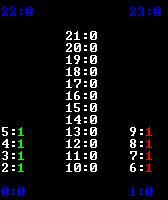4 Renewable Energy Sources
Most renewables originate from the sunTidal from gravityGeothermal from heat trapped in the earth Solar-thermal-PV
Indirect solar-Wind-WaveThese will be renewed naturally, won't run out.
Presently more expensive than fossil fuels but attractive
due to lower environmental impacts
5 Energy Services and Efficiency Improvement
Efficiency : 2 thirds of the energy ends up as waste heat
Energy has been reducing in price so little incentive to
attempt to improve efficiency.
Supply side: generation efficiency can be improved...Combined Cycle Gas Turbine (CCGT) uses hot exhaust gases
from gas turbine generator to power a steam generator.CHP Combine Heat and Power, uses waste heat from power
stations to heat buildings8% of energy lost through transmission/distribution
Demand side:More efficient appliances (must be wary of embedded carbon,
co2 produced in the creation of a new appliance can outweigh
any benefit from energy saved in use) Social changes (walking cycling to work, public transport)
Four sectors: Domestic (draught proofing, insulation) Commercial & Institutional Industrial (reuse waste heat, product design, thinner
materials) Transport
6 Energy in a Sustainable Future
How to improve sustainability:Carbon sequestration (storing carbon so it cannot get back
into atmosphere)Fuels switching - to less polluting fuelsSwitching to renewablesDemand side efficiency improvements
Royal Commission on Environmental Pollution (RCEP) proposed
four scenarios for the UK which consider the options
available for balancing supply with demand given the need to
reduce CO2 emissions by 60%.
World Energy Council has come up with six scenarios
incorporating different assumptions about rates of economic
growth in rich and poor countries; choices of technology and
its development; and the priority given to ecological issues
A number of paths to sustainability, but, since they rely on
different mixes of technology, they are likely to have
different social, environmental and political implications.
03 November 2009
Writing an XNA Game
 I'm writing a board game in C# with the intention of getting it to run in XNA.
I'm writing a board game in C# with the intention of getting it to run in XNA.I don't want to get distracted with xna and graphics just yet. I want to have a working game first. The approach I am taking is:-
1. Create a console app.
2. Get it to initialise and display the board as text. Each of the 24 squares on the board is numbered (0 - 23) and the pieces are represented by red or green non-zero values. An empty square is shown as a white zero. Start squares and home squares are in blue
3. I have added code to capture how the pieces move from square to square.
4. Also added rules, for checking when the game is over and who won, and preventing any illegal moves.
5. I have added a game loop so you can play a game human vs human.
This is working well so far, but the display is not easy to read in a console app.
Subscribe to:
Comments (Atom)